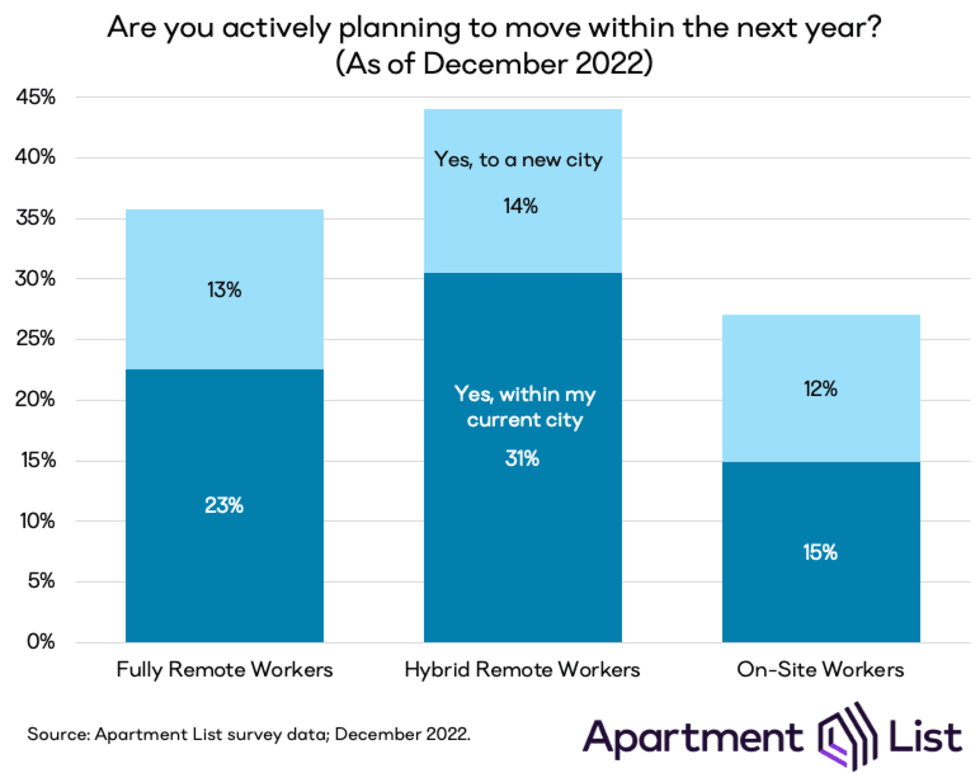 According to Chris Salviati, a Senior Housing Economist at Apartment List, the necessary adoption of remote work at the outset of the COVID-19 pandemic has played a key role in explaining the turbulence the rental market has seen in the last three years.
According to Chris Salviati, a Senior Housing Economist at Apartment List, the necessary adoption of remote work at the outset of the COVID-19 pandemic has played a key role in explaining the turbulence the rental market has seen in the last three years.
But as home affordability becomes an unreachable goal for many Americans, the advent of remote work is helping workers relocate from expensive markets to more affordable ones as the flee from urban cores to the suburbs and beyond in search of attainable housing.
While some employers have mandated that remote workers return to the office full-time, remote work continue to be far more prevalent than it was before the pandemic. Census data shows that the number of those that work from home tripled between 2019 and 2021.
Knowing this, Apartment List surveyed nearly 6,000 adults in December 2022 and overall found that those with a remote job were far more likely to migrate and move into a new home than those with a traditional job.

Among workers whose jobs require them to be fully on-site, 17% moved in 2022. Meanwhile, 27% of workers in fully remote jobs moved, meaning that this group was 56% more likely to have moved than the on-site workers. The highest moving rates were observed among workers with hybrid remote arrangements—those who split time between working at home and on-site—31% of whom moved in 2022, a rate of mobility that was 78% greater than that of on-site workers.
“For the survey respondents who told us that they moved in 2022, we followed up with a more detailed question on the factors that motivated those moves,” Salviati said. “We found that those with remote working arrangements were not only more likely to move, but also considered different factors when they did so. A desire for more space was a major concern for both on-site and remote workers, with 25% of both groups telling us that they moved into a larger home. However, factors concerning geographic preference were far more important for those with remote flexibility.”
Twenty-three percent of remote workers reported that their move gave them access to additional desired amenities, compared with 10% of on-site workers. Remote workers also indicated that their move placed them closer to family and friends, as they are not bound by job locations; in fact, more than 20% of remote workers who moved in 2022 told Apartment List that their remote work status was a motivating factor for their move.
“Given the skyrocketing growth in housing costs in recent years, it is no surprise that affordability was also a major concern for both groups,” Salviati continued. “Roughly equal shares of remote and on-site workers told us that they moved to reduce their monthly housing costs (23% and 22%, respectively). However, 21% of remote workers told us that they moved to a more affordable housing market, compared to just 14% of on-site workers. While remote workers may be able to relocate to alleviate affordability woes, on-site workers are bound to their job location, making such moves far less feasible.”

Remote workers who migrated were also less likely to purchase a home than renting a home.
Looking ahead, survey results seem to imply that this trend will continue throughout 2023. 27% of on-site workers told us that they are planning to move in 2023, compared to 36% of fully remote workers and 44% of hybrid workers.
“Our survey also indicates that we should expect greater movement among remote workers to persist beyond 2023,” Salviati concluded. “Among those not planning a move this year, we asked about longer term plans—11% of fully remote workers told us that they are very likely to move to a new city within the next three years, compared to 6.5% of hybrid workers and just 3.5% of on-site workers.
Click here to view the research in its entirety.

 DSNews The homepage of the servicing industry
DSNews The homepage of the servicing industry









